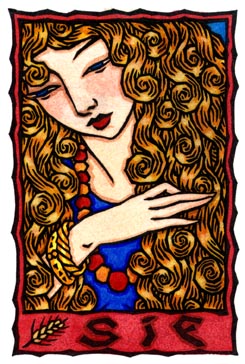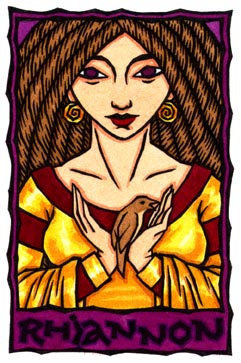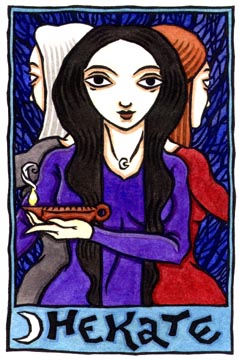
This is the first time Arianrhod has come up. She is a Welsh Goddess Whose name means 'Silver Wheel' or 'Silver Disk'; She is usually interpreted as a Moon Goddess, but I tend to see Her more as a Star Goddess, since the Moon does not turn like a wheel, but the Stars do appear to. It is hard to tell, though, since what we know of Arianrhod is through the medieval Welsh collection of tales called the Mabinogion; for by the time it was written down the old stories of the Deities had been Christianized into fairy tales. Sure, there is plenty of magic and the supernatural in the Mabinogion, but the original Divinity of some of the characters does look to have been downgraded and hidden away.
In the Mabinogion Arianrhod is a candidate to be the foot-holder of Math, a position that one has to be a virgin to hold. When She is magically tested for said virginity by Her brother, the magician Gwydion, She immediately gives birth to twins, putting the lie to Her claim. One of them, Dylan, dives straight into the Sea; the other, Lleu, is a formless thing that Gwydion claims.
Arianrhod wants nothing to do with Lleu; so Gwydion brings Him up, periodically tricking Arianrhod into giving Her son what He can only be given by His mother; each time She is tricked, She heaps scorn upon the both of Them, accusing Gwydion of perpetuating Her shame at not being a virgin by throwing Her son in Her face.
But each time Her refusals are overcome through the magic and trickery of Gwydion, and Lleu gains a name, is armed, and even obtains a wife, the maiden Blodeuwedd, Whom Gwydion and Math create out of flowers. That, however, ends rather badly (see any of the previous posts on Blodeuwedd linked in the tag below).
That, at any rate, is the story in the Mabinogion.
Now, let's first get the family relationships straight. Arianrhod is the daughter of Dôn, Who is the Welsh Mother Goddess, the equivalent to the Irish Danu, the mother of the Sidhe or faery-people. She has (at least) four brothers: Gwydion, Gofannon, Amaethon, and Gilfaethwy. Their names represent some very fundamental skills, the sort of basic building blocks of civilization: Gwydion's name means 'Knowledge,' Amaethon's 'the Divine Ploughman,' and Gofannon's 'Smith.' (I was unable to track down the meaning of Gilfaethwy's name.) Math fab Mathonwy (Math son of Mathonwy) is Dôn's brother, Their uncle, Who, like Gwydion, is also a great magician.
Remember, the tale in the Mabinogion has been straightened up for a Christian audience, the probably Divinity of the players downgraded or glossed over. There are pieces missing. And so there is no outright mention of Who the father of Arianrhod's sons might be. And while it's tempting to go the route of 'well it must be an older virgin mother scenario that was hidden in a vast Christian anti-woman and anti-Goddess conspiracy' (and while I usually do tend to that), this time I don't think so.
The internal evidence, such as it is, points to Arianrhod's brother Gwydion being the father. Lleu is in fact called His 'son' in the tale, though perhaps this refers to His position as adopted son. (And, no, I am not just making this up; I am getting this from MacKillop's Dictionary of Celtic Mythology.) Now, in myth, incest is not the same as it is in reality, where it is a taboo, shameful, horrific thing; in myth, it can simply be a shorthand way of saying the pair are considered equals, in the way that Isis and Osiris, Freyja and Frey, and Hera and Zeus were sister and brother.
But by the time of the Mabinogion that's all been buried; and there is only the barest hint of incest. What we are left with, as explanation for Arianrhod's extreme anger towards Lleu, Her own son, is Her shame at being exposed as not a virgin.
It is hard to say. Nowadays that is not considered the end of the world, or even all that important, really; though, it's true, virginity (in women, of course) certainly was very much prized in some ancient societies. But something never quite rang true for me. That alone never felt like a good enough reason for Arianrhod's utter rejection and hatred of Her son.
But when I looked at Arianrhod as the victim of rape it all fell into place. (My version of Her tale is here.) Her hatred towards Lleu, Her own innocent child, then takes the place of Her anger at Her brother Gwydion, the powerful magician Whom She can not touch.
A modern feminist reading? Maybe. Though rape is certainly not a modern phenomenon, and I don't imagine that women, being human, have had vastly different experiences of it through the ages.
There is this, though:
In a related tale in the Mabinogion, Math's virginal foot-holder is one Goewin. Gilfaethwy, however, conceives a lust for Her, and with the help of brother Gwydion hatches a scheme and rapes Her while Math is away; when Goewin tells Math what Gilfaethwy did to Her, Math offers to marry Her, elevating Her to a position of honor as queen; He also punishes Gwydion and Gilfaethwy by transforming Them into a pair of beasts for three years. Each year one takes His turn being the female and bearing young; at the end of the three years They are considered punished enough. (I don't know if Goewin, however, thought it sufficient.)
This is the situation that necessitates Math finding a new virginal foot-holder, and which leads to Gwydion's suggestion that Arianrhod apply. On one level that doesn't even make sense: if Gwydion is the father of Arianrhod's twins, then for sure He must know She is not a virgin. Is He trying to punish or shame Her further? Or is it simply a detail that has not been thought through, some piece gone missing by the time it was written down in fairy-tale form?
I have always found the psychological analysis of fairy tales fascinating; the sort of thing Bruno Bettleheim did in The Uses of Enchantment. That way of figuring dips back into very primal, archetypal ideas. Wicked step-mothers are a way of splitting off bad behavior unacceptable in an actual mother; and mothers can be further split off into more than one character. (For example, in Hansel and Gretel, the wicked step-mother who hatches the plan to abandon the children and the cannibalistic witch in the bread house are the same figure at some level.)
I've really got no evidence for this, I suppose, beyond a hunch, but I suspect that Arianrhod and Goewin are in some ways different aspects of the same character. They are both foot-holders to Math (which is in itself a puzzling title or occupation; all it says is that Math had to have His feet in the lap of a beautiful and virginal young woman. I don't know what else it is implying); They are both entangled with Gwydion, Who obviously has no scruples when it comes to facilitating rape. I mean it's all been sort of made logical and fit into an actual, non-mythological timeline; but there is something moving around under the surface of the stories. I don't know; but I find it fascinating and disturbing.
So what does my long, rambling digression mean for the meaning of this card? I don't know. Let's just go back to the card itself, for a moment.
At very first glance, Arianrhod as a Star Goddess with Her back to the North Star would seem to fit quite well with the time of year up here in the northern hemisphere, with the winter solstice just past; the idea of north, the direction defined by the Earth's axis, and the still point in the whirling about of time, that moment when the sun is said to stand still before turning back the way it came. And that fits with the whirlwind cards that have been coming up lately, Oya and Kelaeno the Harpy. Though this time, the focus is on the still point, and maintaining yourself in that space while all is whirling about you; as ever, this time of the year is a good time to go inwards into the dark and the stillness.
But the dark is also where the fascinating and disturbing lives, the layers underneath, the meanings, concepts and motivations that cannot be approached by logic but must be intuited out. I would say try to spend some time there this week, feeling out old tales of your own; pay attention to dreams, especially, but also other stories and myths (both cultural and personal) that catch your eye. Something's up. On a very basic level the year has turned; look for evidence of that turning, of a shift in the current of the psyche's Sea which may bring formerly deep things towards the surface. I'm not sure what kind of specific advice to give; I think the point is that you will have to figure it out for yourself.
Let's see what She says:
I whirl but I am not dizzy. I am solid in myself, in my anger, in my knowedge that I am right. Deep in my bones I am I, myself, me, and I know it.
It is all panic and war-plans and lies when there is in fact peace. Shoemakers misusing their skills, all a plot, a plan, a surface shuffling about of colors. It does not affect the underlying story, the reality of it. Destiny is destiny, after all, and I am the Woman with my back to the Deep, the north star, the straight line, the center, the axis; there is no fooling me, no getting around the Fate I proclaim. And so the pretty flower-woman is Death in disguise, for my Son does not escape his destiny.
All is fate and spinning and round and round the center. Trying to keep track of the whirling is a waste of time and energy, though it may be pretty; find the center. You can admire it all from there without being caught up in it. It is much quieter, here, much more conducive to thought and contemplation, which is what you need right now.
Come.
What do you think?
References:
The Mabinogion, translated by Gwyn and Thomas Jones
The Dictionary of Celtic Mythology, by James MacKillop
This isn't anything related to the Arianrhod tale, but it did get me thinking: a psychological analysis of maternal cannibalism in the Hansel and Gretel tale (as well as Snow White and Little Red Riding Hood) by Tracy Willard is here.





















